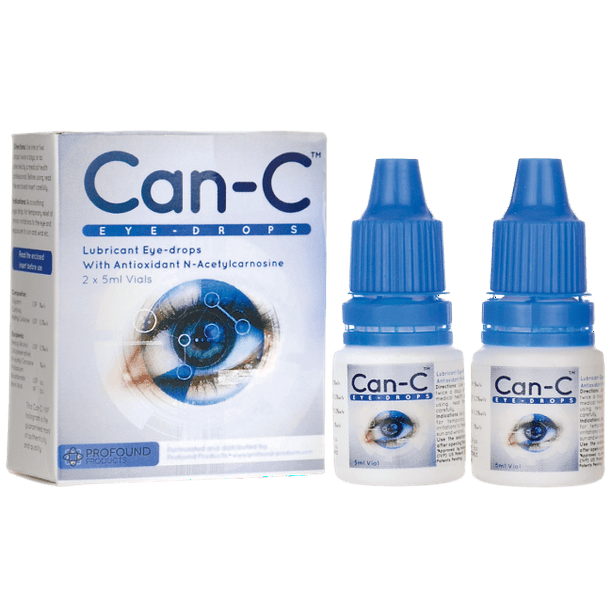My left eye has been going fast. I got some stuff for sugars eyes, she was blind. She passed before I could see it worked for her but. I started using it and I just finished one bottle, and DAMN,,,,,,,,, My vision is coming back and last night when I used it and I opened that eye I could see Crystal clear!!!!!!! But of course that was a one time thing right now. This stuff called CAN_C clams to dissolve cataracts in the eyes. Well it is working, it is getting smaller and when I opened that eye it must have moved a little in that eye. That is their claim they can dissolve the cataract over the period of 3 months. I am pretty jazzed about this. Wanted to make sure it works before I said anything........
Can-c lubricant eye drops with n-acetylcarnosine 2 - 5 ml vials

How does (Can-C⢠N-Acetylcarnosine) actually work to reverse cataracts?
canc-work_01It is now known that cataracts are the result of elevating levels of âascorbate oxidationâ or oxidative stress due in part to oxygen free radicals in the eyes of humans and animals. This unchecked oxidation results in the cross linking of lens proteins, which is a slow glycosylation process. Cross linking of the lens proteins eventually causes a yellowing or browning pigmentation of the lens or (lens opacification) limiting the amount of light that reaches the retina, resulting in worsening vision.
This degenerative process occurs and advances as the natural antioxidant supply in the eye diminishes. Critical antioxidant supplies are continually being tapped from the eye, for protection against; over exposure to ultraviolet light, against toxins and chemicals present in the air we breathe, the food we eat, against the hours we spend looking at our computer screens, and so on.
canc-work_02
Researchers recently learned that the healthy eye contains high levels of the natural antioxidant carnosine. Interestingly the eyes of those suffering from degenerative ocular diseases such as cataracts were found to be grossly deficient in this essential ocular antioxidant.
The prime ingredient in Can-C⢠is a proprietary form of N-acetylcarnosine, a highly specific intraocular released form of carnosine which acts as both a stabilizer and carrier for the di-peptide L-carnosine, safely delivering it into the aqueous humour of the eye, (the fluid area surrounding the lens). It is here, that the bio-identical antioxidant becomes most active in its ability to act as a natural and highly effective anti-oxidant. Important Note: Years of research were spent to identify a specific purity level of N-acetyl-carnosine (NAC) that that would ensure both safety and optimal results. This purity level is highly proprietary and only the patented Can-C N-acetylcarnosine eye drops should be applied to the eyes. Look for the approved Can-C hologram on the box of any Can-C eye drop product prior to applying to the eyes. â Innovative Vision Products.
canc-work_04 Dr. Mark Babizhayev of Innovative Vision Products (IVP), also makes it quite clear that common L-carnosine if used in a non- approved n-acetylcarnosine formulation will not be of much use in the treatment of senile-cataract. This is because there are many synthesized âcarnosinesâ and their biological and medicinal activity strongly varies depending upon how and where they are sourced. For example, if carnosine is extracted from meat muscle substances, the biological and anti-oxidant activity is very low. This is presumably due to the contamination of the âpureâ carnosine substance by heavy metal salts and proteins and other related impurities. It is very complicated to effectively purify carnosine chromatographically, as the compound chelates divalent metal ions very heavily and the biological and anti-oxidant activities can not be regenerated during the purification procedures. In conclusion, there were many forms of carnosine, which were abandoned, in the Russian studies because of their lack of anti-cataract and anti-oxidant ability in the human eye. However, Innovative Vision Products (IVP), in conjunction with their Japanese partner, have researched, developed and patented a highly specific purity factor of the n-acetylcarnosine raw material which has excellent biological activity and has been proven effective in controlled human lens studies. Only the Can-C⢠formula was used in the clinical trials. click here
So what is the difference between Carnosine, L-Carnosine and N-acetylcarnosine?
There are different forms of carnosine; the best known is L-Carnosine and much has been published as to its impressive antioxidant and anti-aging benefits. N-acetylcarnosine which is a specific intraocular released form of carnosine is significantly different from L-carnosine although related. In addition to the proprietary, highly specific purity level of the n-acetylcarnosine that is used in Can-Câ¢, the acetylation process is what makes n-acetyl-carnosine suitable and stable in the eye. Unfortunately L-carnosine by itself, when applied topically, is easily broken down by a dipeptidase enzyme that is present in blood plasma known as carnosinase, and therefore is not deliverable into the aqueous humour of the eye. Furthermore, there are indications that a topical eye application of L-carnosine by itself may release the toxic compound, histamine, (which can severely promote oxidation reactions and therefore could cause other eye-problems with long-term use. This means that L-carnosine by itself is not suitable for eye-drop use as it is either ineffective, or could even be damaging to some tissues over time.
The acetylation component of N-acetylcarnosine (Can-Câ¢) makes it very stable and highly resistant to carnosinase. Additionally this stabilized compound protects against oxidative stress in the lipid phase of biological cellular membranes and in the aqueous environment by a gradual intraocular turnover into L-carnosine maintaining a longer active therapeutic concentration of carnosine directly within the aqueous humour and the lens of the treated eye. Again the purity level of this particular n-acetylcarnosine is critical to its effectiveness.
(IVP) N-Acetylcarnosine Action(s):
Anti-glycation properties reverse cross lining of lens proteins.
Protects against oxidative stress both in the lipid phase of cellular membranes and in the aqueous environment.
Protects structural proteins of the lens/ alpha-crystalline, from the free-radical induced oxidation process.
Deliverable and stable at the cellular level.
http://www.wisechoicemedicine.com/science-and-research/how-why-can-c-reverses-cataracts/
